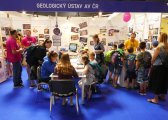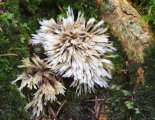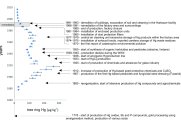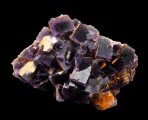News archive
News older than one year.
Vlhošť Hill: the landmark of northern Bohemia covered by a new book
Czech landscape features many hills whose complex geological history is reflected in equally varied geomorphology. The Dokořán publishing house now released a publication devoted to the volcanic hill of Vlhošť, surrounded by a labyrinth of sandstone cliffs. The book was authored by Jiří Adamovič and Václav Cílek of the Institute of Geology in collaboration with Kamil Podroužek of the university of Ústí nad Labem.
Amber Road
After a decennial collaboration, a voluminous monograph was published on the Amber Road, which once connected the Adriatic Sea with the Baltic Sea in a north–south direction. The route starts in the Polish Lowlands of the lower Vistula River, where amber artefacts were produced in vast manufactures. Although the book describes the whole course of the route, it concentrates on the important area between Vienna, the Pavlovské vrchy Mts., the Brno area and central Moravia. This is where the authors (P. Bolina, J. Martínek, V. Cílek and P. Šlézar) mapped the remains of old trails and wagon ruts connecting prehistoric dwellings, medieval castles and monasteries using LIDAR within two extensive research projects. The book, published by Academia, contains over 500 figures, of which around 350 are maps showing the courses of the trails.
Science Fair 2022
Institute of Geology took an active part in the Science Fair, which was held at the PVA EXPO Fairgrounds in Prague-Letňany in the first days of June. The fair presented over 100 expositions of most Institutes of the Czech Academy of Sciences and many other institutions and companies. Much like in previous years, the stand of the Institute of Geology attracted by the display of fossils and minerals but also by thematic posters presenting the Institute activities. Very successful was the observation of fossils with a microscope and geological quizzes: the successful responders could take away a mineral of their choice. The quizzes were attended, individually or in groups, by over 350 visitors of various ages. The stand was visited by about 2000 people! It became attractive for professional photographers, too. Therefore, seven photos of the stand were included in the official gallery of the Fair.
Hyperaccumulation of elements in mushrooms
Thelephora mushrooms are important mycorrhizal partners of woody plants. An international team led by Jan Borovička of the Institute of Geology investigated trace element concentrations in their fruit bodies. In Thelephora penicillata, extremely high concentrations of toxic elements were found, especially cadmium (Cd) and arsenic (As). Among other analysed species, surprising results were obtained for T. palmata with elevated contents of sulphur and T. vialis with extremely high concentrations of selenium.
Research Reports in a new outfit
The annual report of the Institute of Geology was published lately – in a completely new, modern graphic layout. Research Reports bring a review of the most important information and research outputs of the Institute connected with the year 2020. To access this volume, click here.
Larch – an archive of mercury concentrations
A paper by scientists of the Department of Environmental Geology and Geochemistry was published in the prestigious journal Environmental Pollution. The study of tree rings in European Larch determined the evolution of mercury (Hg) emissions from a local source. Larch is a living recorder of Hg concentrations in the air. In this case, the emission source was the oldest chemical plant in the German town of Marktredwitz, which was producing Hg-based fungicides. Its environs were contaminated during the centennial operation of the plant. Mercury then started to spread to the Czech Republic through streams, inducing contamination of sediments in the Skalka Reservoir in the Cheb area. The record in larch rings suggests that the highest Hg emissions occurred in the first decades of the 20th century, when the plant was the World's key producer. The present Hg concentrations in the air are very low due to the extensive remediation of the whole plant area.
In memory of Magda Konzalová
On 14th March 2022, our colleague Magda Konzalová suddenly passed away at the age of 87. She was an expert in palynology of Tertiary sediments but worked also in the Proterozoic and Cretaceous. Although she started her career in the geological prospection of the Geoindustria company, she spent most of her professional life at the Department of Paleobiology and Paleoecology of the Institute of Geology of the Czech Academy of Sciences. She trained several followers. Her passing away is a great loss not only for her students but also for her colleagues in the Czech Republic and abroad. Nevertheless, her work is staying to the benefit of future generations. Her memory be honoured.
Institute of Geology stands in full support of the people of Ukraine

Institute of Geology of the Czech Academy of Sciences denonces Russian agression and Russia's violent intervention in Ukraine, thereby joining the Czech Academy of Sciences in the support of Ukraine in this difficult situation.
The new book about igneous rocks
The oldest geological society in the world – The Geological Society of London – has recently published a book "Lamprophyres, Lamproites and Related Rocks: Tracers to Supercontinent Cycles and Metallogenesis". The book deals with igneous rocks which originated at great depths in the Earth's mantle and provide unique potential for the study of geological processes involved in the formation and break-up of geological supercontinents such as Colombia, Rodinia and Gondwana–Pangea. The main editor of the book is Assoc. Prof. Lukáš Krmíček, Ph.D.
2022 – The Year of Mineralogy
The International Mineralogical Association declared 2022 the Year of Mineralogy. The purpose of this global initiative (briefly named Mineralogy 2022) is to highlight the importance of mineralogy in our everyday lives. Mineralogy 2022 will consist of various activities of regional, national and international levels, which should emphasize the importance of mineralogy as an interesting modern but fundamental science that may interest wide public. The Institute of Geology will join this initiative via several activities, including an exhibition within the Science Fair, lectures for wide audience or articles in popular magazines.










